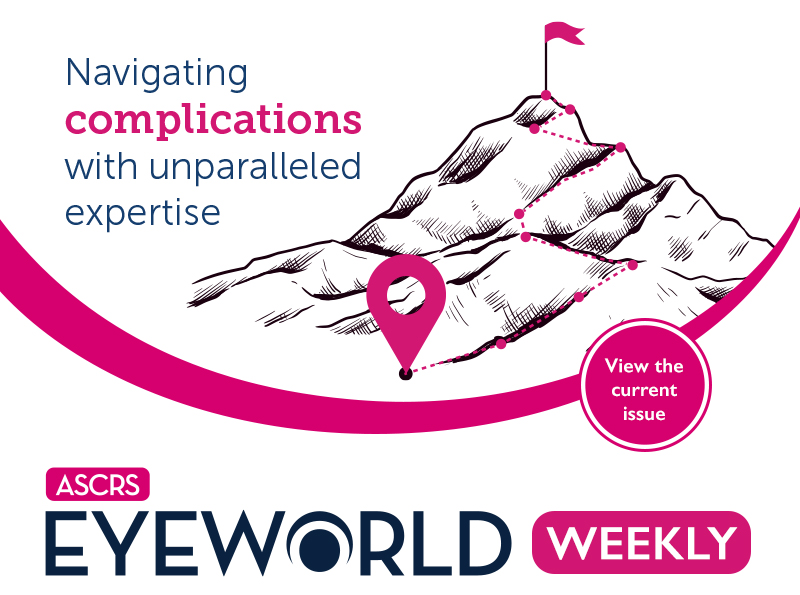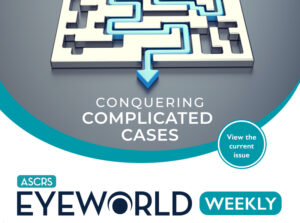
- Positive Phase 3 results in trial investigating topical diabetic macular edema treatment
- Positive topline results in Phase 3 trials for retinal vein occlusion treatment
- IND filed for drug to treat neuropathic corneal pain
- Trial for ‘first-in-class anti-VEGF-complement dual targeting drug’ begins dosing patients
- Complimentary access to video journal
- ASCRS news and events
October 13, 2023 • Volume 29, Number 19
Positive Phase 3 results in trial investigating topical diabetic macular edema treatment
Oculis reported positive results in Stage 1 of its Phase 3 clinical trial for treatment of diabetic macular edema with OCS-01. According to the company’s press release, primary and secondary endpoints were met with a statistically significant improvement in best corrected visual acuity in the treatment group vs. vehicle at week 6. More patients achieved a 15 or more letter improvement in BCVA in the treatment group vs. vehicle, and patients in the treatment group showed significant improvement in retinal thickness compared to vehicle. The Phase 3 trial is ongoing. OCS-01, if approved, would become the first topical eye drop to treat diabetic macular edema, the company reported.
Positive topline results in Phase 3 trials for retinal vein occlusion treatment
Genentech announced positive topline results from its Phase 3 trials investigating extended treatment intervals with Vabysmo (faricimab-svoa) for branch and central retinal vein occlusion. According to the company’s press release, participants in the trials who had extended treatment intervals (up to every 4 months between 24–72 weeks after initial dosing period) maintained vision gains that had been achieved in the first 24 weeks. The company reported that Vabysmo continued to dry retinal fluid from baseline (measured by central subfield thickness) out to 72 weeks. The company stated that this is the “first time vision and anatomical improvements were maintained for more than a year using a personalized treat-and-extend dosing regimen.” Data from the first 24 weeks of the trials has already been submitted to the FDA; a decision is expected late this year. If approved, treatment of RVO would be Vabysmo’s third approved indication (the other two being wet AMD and diabetic macular edema).
IND filed for drug to treat neuropathic corneal pain
OKYO Pharma announced that it had filed an IND with the FDA to begin a 40-patient clinical trial in 2024 to investigate OK-101 as a possible treatment for neurotrophic corneal pain. According to the company’s press release, the open-label trial would evaluate safety and efficacy of OK-101 in a real-world setting. OK-101 is a lipid conjugated chemerin peptide agonist of the CHEMR23 G-protein coupled receptor. OK-101 is already in a Phase 2 clinical trial for treatment of dry eye disease.
Trial for ‘first-in-class anti-VEGF-complement dual targeting drug’ begins dosing patients
Innovent Biologics announced that it dosed the first patient in its Phase 3 clinical trial of efdamrofusp alfa (IBI302), a recombinant fully human anti-VEGF and anti-complement bispecific fusion protein, for the treatment of neovascular AMD. According to the company’s press release, this is a “global first-in-class anti-VEGF-complement dual targeting drug” that could “overcome the current treatment limitations, prolong dosing intervals, reducing the burden of injections on patients, but also demonstrate its potential advantages in long-term anti fibrosis and macular atrophy improvement.” The Phase 3 study will enroll 600 subjects who will be randomized to receive either 8 mg IBI302 or 2 mg aflibercept in prescribed dosing regimens. The primary endpoint is change from baseline in BCVA letters at weeks 44, 48, and 52.
Complimentary access to video journal
The latest issue of the Video Journal of Cataract, Refractive, & Glaucoma Surgery, founded and edited by Robert Osher, MD, is online now.
ASCRS news and events
- ASCRS Live Webinar: “Complex Presbyopia IOLs,” a live educational event, will take place Tuesday, October 24 at 9:00 p.m. ET. Register now for this webinar.
- A Taste of ASCRS: This nine-section CME program recorded from the 2023 ASCRS Summer Meeting is now available on demand. Learn more about the program.
- ASCRS Foundation: National Sight Week is going on now. Learn more about the Foundation’s Operation Sight program, how to donate, and how to get involved.
Research highlights
- A paper published in the laboratory science section of the Journal of Cataract & Refractive Surgery sought to assess whether sunlight could be used to induce biomechanical stiffening in riboflavin-soaked corneas, similar to that which occurs during crosslinking (CXL) with riboflavin and UV-A light. The investigators used 52 porcine eyes and estimated the concentration of riboflavin in the corneal stroma using UV-A transmission, according to the paper. The researchers determined the duration of sunlight exposure that would be needed to achieve fluence of 7.2/cm2. From there corneas were de-epithelialized, divided into 3 groups, and soaked with 0.1% (control and Group 1) or 0.5% riboflavin (Group 2). Group 1 and Group 2 were exposed to sunlight. The investigators observed increased corneal stiffness at both concentrations of riboflavin, with the 0.1% group exposed to a longer UV-A duration showing a greater stiffening effect. The authors concluded that this “might open new alleys for the use of oral riboflavin and fractioned sunlight exposure as less invasive CLX techniques.”
- A meta-analysis of randomized control trials that included patients having age-related cataract surgery who were treated with corticosteroids, NSAIDs, or a combination were evaluated from a safety and efficacy standpoint of the postop drugs. The analysis published in the American Journal of Ophthalmology included 19 studies comprised of 3,473 patients—1,479 treated with NSAIDs, 1,307 treated with corticosteroids, and 687 a combination. The authors reported that the combination treatment “demonstrated favorable best corrected visual acuity compared to corticosteroids 4–6 weeks postoperatively,” and NSAIDs “had more favorable flare values than corticosteroids on day 7, 14, and 4–6 weeks postop.” The authors also reported that 4–8 weeks postop, the NSAID group had a lower central macular thickness compared to the corticosteroid group, and the NSAID and combination groups showed lower incidence of central macular edema compared to corticosteroids. The authors concluded that NSAIDs and combination treatments might be more effective and safer than corticosteroids alone after cataract surgery. “Further studies should be conducted as to why this evidence has not been reflected in practice patterns and to further compare the effectiveness of NSAIDs and combination treatments,” the authors stated.
This issue of EyeWorld Weekly was edited by Stacy Jablonski, Liz Hillman, and Ellen Stodola.
EyeWorld Weekly (ISSN 1089-0319), a digital publication of the American Society of Cataract and Refractive Surgery (ASCRS), is published every Friday, distributed by email, and posted live on Friday.
Medical Editors: Sumit “Sam” Garg, MD, Chief Medical Editor, Mitchell Weikert, MD, Cataract Editor, Karolinne Rocha, MD, PhD, Refractive Editor, Julie Schallhorn, MD, Cornea Editor, Manjool Shah, MD, Glaucoma Editor
For sponsorship opportunities or membership information, contact: ASCRS • 12587 Fair Lakes Circle • Suite 348 • Fairfax, VA 22033 • Phone: 703-591-2220 • Fax: 703-591-0614 • Email: ascrs@ascrs.org
Mention of products or services in EyeWorld Weekly does not constitute an endorsement by ASCRS.
Click here to view our Legal Notice.
Copyright 2023, EyeWorld News Service. All rights reserved.



